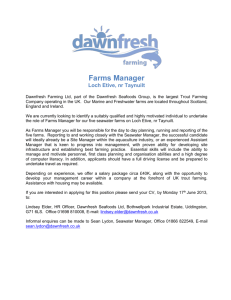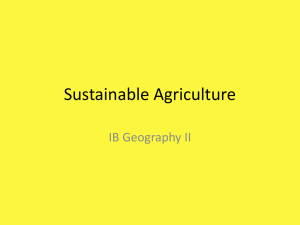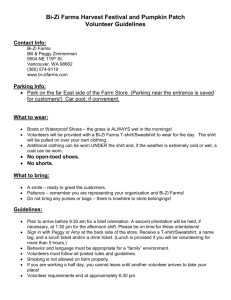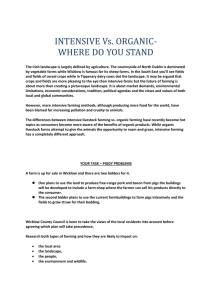File
advertisement
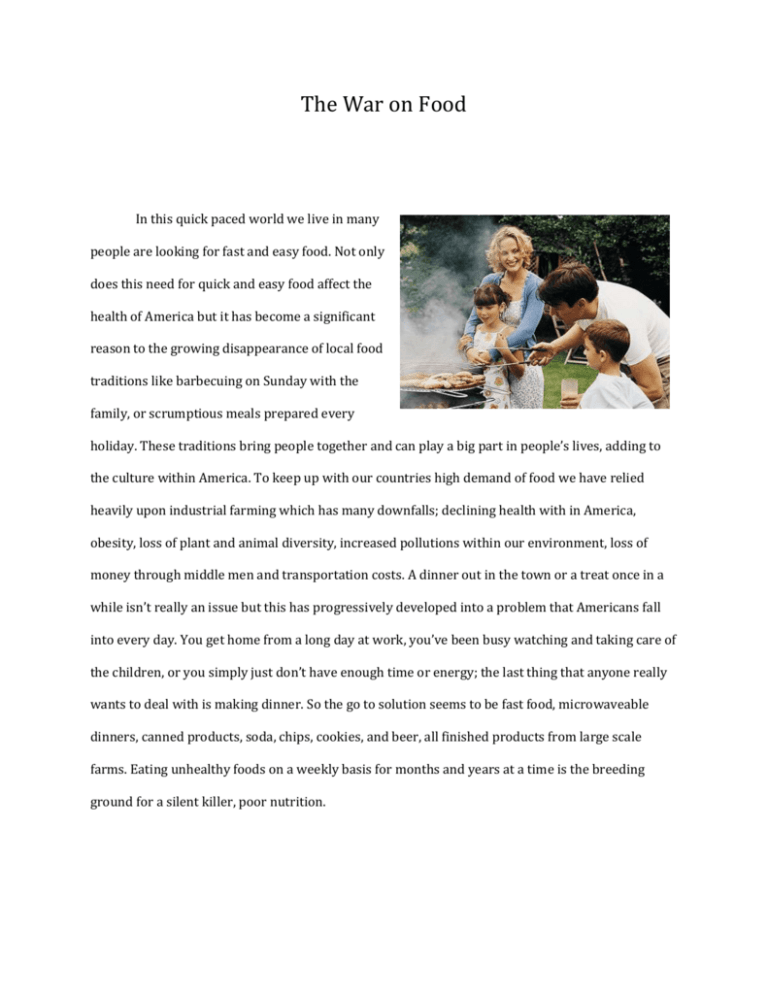
The War on Food In this quick paced world we live in many people are looking for fast and easy food. Not only does this need for quick and easy food affect the health of America but it has become a significant reason to the growing disappearance of local food traditions like barbecuing on Sunday with the family, or scrumptious meals prepared every holiday. These traditions bring people together and can play a big part in people’s lives, adding to the culture within America. To keep up with our countries high demand of food we have relied heavily upon industrial farming which has many downfalls; declining health with in America, obesity, loss of plant and animal diversity, increased pollutions within our environment, loss of money through middle men and transportation costs. A dinner out in the town or a treat once in a while isn’t really an issue but this has progressively developed into a problem that Americans fall into every day. You get home from a long day at work, you’ve been busy watching and taking care of the children, or you simply just don’t have enough time or energy; the last thing that anyone really wants to deal with is making dinner. So the go to solution seems to be fast food, microwaveable dinners, canned products, soda, chips, cookies, and beer, all finished products from large scale farms. Eating unhealthy foods on a weekly basis for months and years at a time is the breeding ground for a silent killer, poor nutrition. Obesity is the #2 cause of preventable death in the United States 60 million Americans, 20 years and older are obese 9 million children and teens ages 6-19 are overweight Being overweight or obese increases the risk of health conditions and diseases including: Breast cancer, Coronary heart disease, Type II diabetes, Sleep apnea, Gallbladder disease, Osteoarthritis, Colon cancer, Hypertension and Stroke. (statistics-obesity-in-america.html) The average American family spends 90% of their household food budget on processed, packaged unhealthy food. Unfortunately, most processed foods are full of sweeteners, salts, artificial flavors, trans fats, colorings, preservatives and chemicals. Processed foods are often stripped of nutrients that were designed by nature to protect your heart, such as soluble fiber, antioxidants and healthy fats. Combine the lack of nutrients with these unhealthy additives, and you have a recipe for disaster. Research has revealed that trans fats are twice as dangerous for your heart as saturated fats, and are responsible for an estimated 30,000 to 100,000 premature heart disease deaths each year (graph/hea_obe-health-obesity). Choosing refined grains over whole grains can boost your heart attack risk by up to 30%.The sweetest unhealthy food ingredient that has lethal effects is high-fructose corn syrup. Today, we consume an average of nearly 63 pounds of it per person per year in drinks and sweets, as well as in other products. Research suggests that this liquid sweetener may upset the human metabolism, raising the risk for heart disease and diabetes. High-fructose corn syrup’s chemical structure encourages overeating (what-makes-certain-foods-unhealthy/). Buying food locally greatly helps with this problem. Food can be just as much of an addiction as any other substance or prescribed medication. For some it’s quite obvious why not to dabble with certain drugs; they are illegal, they can cause tremendous health problems, they alter your state of mind for the better or worse, and they are used as an outlet or way of escaping from everyday problems and worries that come and go through out your life. I dare say that food can have the same disastrous affects and has become another substance that people abuse. I think this can be mistaken at how serious of a problem it can become. Undeniably so it’s a necessity of life, and a balance must be found. When looking at the obesity rate of countries such as the United Kingdom, America compared to other counties, we have Slovakia, Greece, and Mexico top out in the nestled ourselves nicely at the top of the low 20 percentile range, Mexico is the runner charts. Research shows that 30.6 percent of up to America with 24.2 percent of its the total population in the U.S. has a BMI population is estimated to be obese index greater than 30, which means they are (graph/hea_obe-health-obesity). overweight. All of the other competing This paper is not on obesity I am merely trying to point out one of the many problems that have come from our negligence of this war on food. So how does one draw the line between getting the necessary nutrition he or she needs to survive and becoming gluttonous, constantly satisfying any urge to consume unhealthy food? This is where Slow Foods organization comes into play. Slow Foods is a growing and prospering cause which took great time and effort by many people to get to where it is today. This program is an organization that is committed to helping people live a healthier lifestyle by buying and selling food locally. Not only does this offer a means of help with the expanding causes and problems associated with obesity, but there are many other benefits to buying locally. Buying food locally directly contributes to your local community, and enables restaurants, families, and individuals alike to get the best quality food available. Many local farmers are now utilizing organic farming principles and focus their attention on the quality of the food, avoiding pesticides, insecticides, and herbicides that conventional farming and industrial producers thrive on. These chemicals affect our society, our environment and our economy in many ways; pesticides were found to pollute every stream and over 90% of wells sampled in a study by the US Geological Survey (Enviromental_impact_of_pesticides), it is a major contributor to air and soil pollution, it affects insects and animals alike, causing health issues and destroying their food chain. By killing small insects within a local ecological system you create a chain affect where animals are unable to feed on a once plentiful source of food thus hurting and altering the once balanced ecosystem in that area. This can have a ripple effect and cause many more issues getting exponentially worse as time goes on. Last but not least, those chemicals affect many plants that we thrive on, adding unhealthy nutrition to our foods Local farms are usually smaller farms that are able to better monitor the quality of the product grown naturally to its full potential. Growing food organically will give it better taste, size, color, and nutritional value. This also helps side step many issues that arise from large scale production farms. All chefs alike, whether in a restaurant or at home, can go to a local food market and pick produce which was growing in the field that same week. This offers people an alternative to canned produce and packaged food that is full of unhealthy preservatives and trans fats. Buying food or livestock locally creates a more upfront, personal, fresher and economical product and allows for a more direct and personal relationship between you and the supplier. The industrial model relies heavily upon fossil fuels and oils to keep business productions running smoothly. As these commodities continue to decrease the industrial food market prices will sky rocket. Half of the world’s seed supply can be traced back to three large companies; this consolidation is a threat to biodiversity and an assault on our choice when it comes to food. (Bates, 2009) The crises that will arise from the continued industrialization of food is the loss of biodiversity within our farms. Diversity plays an essential role to a thriving economy and sustainable farm s. Good quality meats and produce stems from a diverse environment. It has been proven that by keeping a variety of animals together within the same farm helps reduce parasites and other harmful factors that lead to diseases and harmful chemicals with in the livestock. (Bates, 2009) The same idea applies to fruits and vegetables. Everything that happens from a well balanced ecological system is good: better flavor, size, color, extended shelf life, and even gives the plant more antioxidants ("Antioxidant" is the collective name for the vitamins, minerals, carotenoids, and polyphenols that protect the body) The race for cheaper food has forced big industry farmers and ranchers to cut costs in any way possible. Cheap labor and shortcuts taken in the farming process lead to improper regulation and food poisoning (ecoli/mad cow disease/salmonella/etc…). This problem affects Americans directly. With America’s continued population growth, the land we have available for farming is quickly disappearing. In the past decade, food intake in America has increased 4 fold, swamping the FDA with the task of inspection. In 2006, of the 200,000 shipments received from china less than 2 % were inspected (Bates, 2009). Buying food locally is a small but essential component to solving this problem. Sustainable farms provide great food with minimal environmental impact, but can it support America’s masses? The answer is not yet. This is one fact we must consider when looking to the future and a big part of skeptics argument. "The overall human demand for animal products is expected to triple or even quadruple in the next 30 years." This is a very valid point! But I dare say that the negative and irreversible aspects that come from industrial farming are extensive. There are many more positive outcomes to local farming. The right decision is not always the easiest way out, and to fix this problem with take great work and effort by all of us."Controlled farming is necessary in less industrialized nations." This may be true in some situations but I do not think necessary is the correct term. Controlled farming should be a practice used in times of great need, rather than the main producer of food. “Without factory farming food prices will increase and many less fortunate families will have to go without food and starve.” This is a very black and white way of thinking; I see many options and ways to keep food affordable and available to those in need. We are far from a point that we could rely entirely on local farms, but that is why it is important that people are aware of the problem and through small steps we could bring this problem back into or more manageable issue. Banning industrial farming is a tall order and a little extreme, but reforming industrial farming is necessary, we must find a middle ground. Where can we go from here? One of the first things I propose and see as a viable means to the solution is a change in the sizes of our farms. Large industrial farms should be made to down size into medium and eventually small industrial farms. At the same time small organic farms should be upsized into medium and large ones. It’s a simple plan, but of course will cost money. I believe a higher tax should be placed on industrial farms and the money reallocated to the communities, through government intervention they would be able to help local farmers become more prevalent in society and keep food illegal immigrants. We can all help put an end cheap for everybody. Because factory farms to the factory farming system by buying our are considered “agricultural” instead of food from smaller, sustainable farms. These “industrial, ” they are not subject to the businesses still aim to profit from their labor, regulation that their scale of production and but that’s not their only objective. They have pollution calls for. Because they employ essentially a triple bottom line - of social, powerful lobbyists that can sway the environmental and financial gain - which government agencies responsible for means they won’t sacrifice the health of the monitoring agricultural practices, industrial land or the quality of food simply to make a farms are left free to pollute, to hire few dollars more. (issues/factoryfarming/) undocumented workers, and to locate their When you buy local fruits, vegetables, and businesses without regard to the impact that meat products, you support your local has on surrounding communities. economy. More of the money you spend goes (issues/factoryfarming/) We must change the directly to the farmers themselves because regulations on these large scale farms, strict less goes to transportation and middlemen. enforcement and monitoring of these policies Buying locally also means burning less fossil is very important. The government needs to fuel to get food from the farm to the table, make it harder for these companies to take which benefits the environment. shortcuts when growing foods and employing Works Cited Bates, R. (Director). (2009). Ingredients [Motion Picture]. Enviromental_impact_of_pesticides. (n.d.). Retrieved July 2nd, 2011, from http://en.wikipedia.org/wiki/: http://en.wikipedia.org/wiki/Enviromental_impact_of_pesticides graph/hea_obe-health-obesity. (n.d.). Retrieved July 2nd, 2011, from http://www.nationmaster.com/: http://www.nationmaster.com/graph/hea_obe-health-obesity issues/factoryfarming/. (n.d.). Retrieved July 2nd, 2011, from http://www.sustainabletable.org/: http://www.sustainabletable.org/issues/factoryfarming/ statistics-obesity-in-america.html. (n.d.). Retrieved July 2nd, 2011, from http://www.getamericafit.org/: http://www.getamericafit.org/statistics-obesity-in-america.html what-makes-certain-foods-unhealthy/. (n.d.). Retrieved July 2nd, 2011, from http://www.simplyslimliving.com: http://www.simplyslimliving.com/what-makes-certain-foodsunhealthy/
